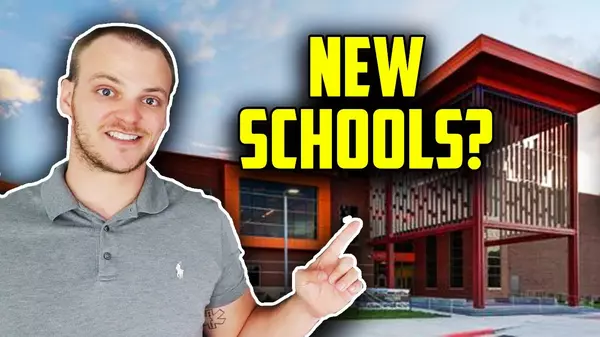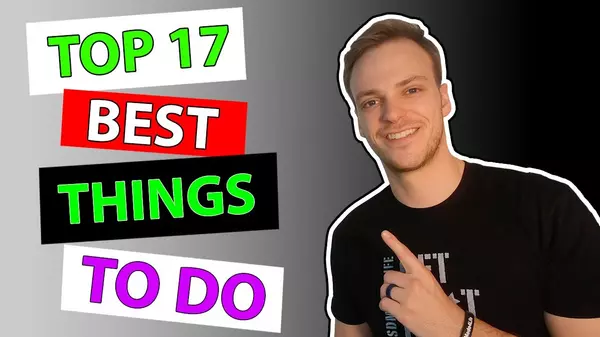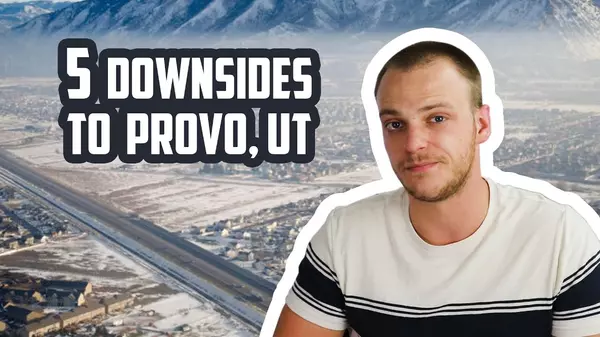Salt Lake City Winter | What Is It Like? Average Snowfall, Temperature, And Inversion
What's up, you guys? It's Cody Steck, your Utah Realtor today. We're talking about what is winter like here in Salt Lake City? I'm going to give you everything you need to know from how much sun you're gonna get to how much precipitation with rain and snow, and what are the ski resorts gonna be like?
And one thing that you're going to want to know is what is the inversion like here during the winter? What is the air quality? So let's jump into it.
Temperature.
So the first thing that I want to jump into is talking about the temperature. What is the temperature like here during the winter?
How cold does it get? What's the average humidity that you can expect? And what kind of layers do you need to put on to survive a Utah winter? Well, the first thing I want to mention is the coldest season. The coldest time of year is generally from about the end of November all the way through February and maybe even into the first part of March.
These are typically the coldest months of the year. You're going to find that the temperatures range anywhere from the 20s up to about the mid-30s on most days. Now we can get down into the single digits where it is going to get really cold. And of course, you'll have a couple of warm days in there as well, where you'll hit 40. Even just recently, we hit 47 degrees here in the winter, so you can get a little bit of variation there.
But typically you're going to be in that 20 to 30 degrees range. As far as humidity goes, you can expect that you're going to find humidity anywhere from about 50% to 70% on an average day here during the winter. One of the things that I love about Utah, and probably one of the things that you'll notice if you're moving here or even if you're just visiting here, is that it's a great place to wear just a light sweatshirt or even a hoodie because you don't get that chilling cold bite that you get in other places. I know that it's very common on the East Coast to get a very cold chilling bite when you're outside, especially with wind chill. But here in Salt Lake, it's actually not too bad.
It's generally pretty quiet as far as windows. And you don't really get that cold bite when it comes to that cold weather, just because of the humidity levels. So it's really nice that you can just wear a sweatshirt and just take it off when you get inside. Hurry and throw it on when you go back outside and you're good to go. And with winter comes a very important thing that you're going to want to know about.
Snow.
How much snow do we actually get here in Salt Lake City? Well, the way that the Valley is laid out, you're going to get the least amount of snow kind of right in the middle of the Valley where i-15 runs. This is the lowest part of the Valley, so that's where you'll see generally the least amount of snowfall, not always, but in most cases. And then as you move east upwards into the Wasatch front, you're going to get increased levels of snowfall. So even if you're on the benches, you can expect at least 20% to 30% more snow.
And as you move up into the mountains, it's going to go up from there. So your snowy season is going to go along with the coldest days of the winter. It's generally going to be from about November through March, although we do get early storms. It snowed on Halloween and even earlier in October before, and you'll get late snowstorms where it's snowing in April, May, I've even seen it snow in June. Again, most of that snow is going to come from December, January, and February, but it does have that little bit wider of a date range there.
So let's talk about how much snow we're actually going to get now. When it comes to the amount of snowfall that you can expect, you're going to find that it's going to vary based on what year. You look at what website where you're tracking it. But overall, you can expect that we're going to get about 50 inches of snow on average here in the Valley. Now, in the mountains, it can be significantly more.
We're going to talk a little bit about the Lake effect snow, which you may have heard of, and that's what makes Utah snow the best snow on Earth. When we get clouds rolling in from the west, they come over the Great Salt Lake and they pick up extra precipitation before dropping it again here on the Wasatch front. So as those clouds roll over the mountains, that's where you're going to get the most snowfall. And that's why the mountains can get hit really hard and the snow is really fluffy and it's an awesome time to ski or snowboard on. Now, if you're looking at the average snowfall for the US, and I know this may be a skewed statistic, just based on whether you're on the coast, whether you're in the south, the north, where your city lies, how high it is in elevation, it's going to vary.
But the US average is about 28 inches per year. Salt Lake, we're about 54, so it's almost double what you'll see in the US average. And we do get a lot of snow here. Luckily, it generally does warm up afterward, so a lot of that snow melts away. It's easy to drive on.
The Department of Transportation here does a pretty good job at keeping the streets clean, putting down salt, which isn't the best for your cars, but it keeps the roads clean and helps to avoid those future accidents and help avoid the ice forming on the streets because it can be a little bit difficult to drive when the snowstorm is here. But give it a day or two and it will clear up. The roads will be plowed, and you'll be good to go. And just because we're talking about the snowfall that you're going to get here in the Wasatch front, we're going to look at the snow report here for Snowbird Utah. I'm going to give you a breakdown of what the snow total say, what you can expect the year to year, what the bases are, and how that's going to look for you if you're planning a ski trip here if you're moving here to do some skiing.
But really quick, guys, if you are thinking about moving here, make sure to get in touch with me. I've got people from all over the country and even internationally who have reached out to me looking for help when it comes to moving to Salt Lake City, and I'd love for you to do the same. I love it when people reach out, call me, text me, email me. My information will be listed down below in this article.
Just get a hold of me anyway that you need to so we can have a discussion about what your lifestyle is going to look like and what type of home you can expect when you move here.
Skiing.
Okay, guys. So I've got the mountain report pulled up here from Snowbird. This is my favorite resort in the entire Salt Lake City area. Park City is probably my close second, but Snowbird is definitely first.
It's a great mountain. They've got tons of challenging terrain, and they've got a fair share of easy terrain as well. So they've got 14 lists. All 14 of 14 lists are open, typically earlier in the year. Not every single one of those lists is going to open right away. You'll generally find that by the middle to end of December, all of those lists should be open. There are 140 trails, of which 135 are currently open.
There are still a few last ones that they need to get open. That's very typical just because we're still kind of early on in the ski season and they haven't had enough snow to fill in all of those trails and make it safe for us as skiers. So the road is open. It's icy and spots. The thing that I want to show you guys here is if I Scroll down current conditions, the depth is 61 inches.
This is the base depth, 61 inches. By the end of the season, that's going to be well over 100 inches. Typically, you'll see anywhere from about 120 to 150 on the base depth here. Year-to-date snowfall is 170 inches by the end of the season. On a good season, this should break 500 inches of snowfall, which is absolutely insane.
It creates great snow and you'll get a ton. We get dumped on with storms at least two or three times a year where we'll get two 3ft in the mountains. And this really just adds up to it. So we're sitting at 170 inches right here. It's December 23, and by the end of the season, as I said, you'll be well over 500 on a good season.
Typically, I've never seen it not go over 400 inches. The highest I saw was like 600 inches. So tons of snowfall going in here. The base temperature is 32 degrees. And upon the peak, it's 19 deg.
So it is fairly cold, but not too bad. The wind does pick up on the peak, so it can get a little bit windy there. But overall, just tons of great snow, tons of awesome things to do if you're up on the mountain, definitely go check out Snowbird if you're in town. And the last thing that I want to talk about here in the winter for Utah is the inversion. You may or may not have heard about the inversion problem that we have here in the Valley.
Inversion.
Unfortunately, this isn't something that we're necessarily proud of, but it is what it is. So I want to tell you a little bit about what to expect here. So what happens in the winter inversion is you've got a warm layer of air that rolls in over the Valley and keeps the cold air underneath. It is trapped inside the Valley. It can't escape because of the mountains that we're surrounded by.
And so that cold air just sits here in the Valley and you can get particulate pollution going on here in the city. Typically, this causes a problem because it is pollution here in our area that we are then breathing. This can cause issues, especially if you've got a respiratory disease or something similar. And so you have to be careful with it. Unfortunately, it is something that's a big hot topic for us right now how to fix this, how to make it better, and how to get around it so that it's not so bad in the future.
Really. What does this mean? Well, it means that we can get pollution here in the city that will stick around longer than it needs to just because it can escape. Typically, when a storm rolls into the city, that pollution and that inversion will be taken out just because of the storm system mixing up the air but whenever we've got a period in between storms that's when the inversion gets the worst and it can produce an unhealthy air quality for people who are sensitive to it. So even for myself, I don't have any diseases luckily but I do notice a difference when I go outside and you're breathing this polluted air it sucks.
So that's definitely a great time to head up to park city head up to the ski resort to get above the inversion so you can breathe some fresh air. Typically these inversions will last anywhere from about three to five days on average, sometimes longer. It just depends on how long in between storms we're going to have but it's important to know what these things look like so you can stay indoors and get out of the pollution. So, guys, that wraps up what it's like to live here in the winter I hope this was helpful for you. I tried to keep it basic, straightforward, and to the point for information that you'd want to know.
If you enjoyed this content please share this with your friends and family members who are interested in moving here to Utah, we cater to the whole state from northern to southern Utah. I'd love for you to be around here. If you're thinking about moving here, make sure to get in touch with me. Call me, text, send me an email, just get a hold of me in any way that you need to. I absolutely love it and last but not least follow me on Instagram @utahrealestate
I try to post that often. I'd love for you to be part of it until next time.
Cody Steck, Realtor
Real Broker, LLC
801- 244- 2297
Cody@fastutahhomes.com
Categories
Recent Posts










GET MORE INFORMATION

